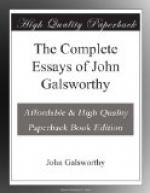But dramatists being as they are made—past remedy it is perhaps more profitable to examine the various points at which their qualities and defects are shown.
The plot! A good plot is that sure edifice which slowly rises out of the interplay of circumstance on temperament, and temperament on circumstance, within the enclosing atmosphere of an idea. A human being is the best plot there is; it may be impossible to see why he is a good plot, because the idea within which he was brought forth cannot be fully grasped; but it is plain that he is a good plot. He is organic. And so it must be with a good play. Reason alone produces no good plots; they come by original sin, sure conception, and instinctive after-power of selecting what benefits the germ. A bad plot, on the other hand, is simply a row of stakes, with a character impaled on each—characters who would have liked to live, but came to untimely grief; who started bravely, but fell on these stakes, placed beforehand in a row, and were transfixed one by one, while their ghosts stride on, squeaking and gibbering, through the play. Whether these stakes are made of facts or of ideas, according to the nature of the dramatist who planted them, their effect on the unfortunate characters is the same; the creatures were begotten to be staked, and staked they are! The demand for a good plot, not unfrequently heard, commonly signifies: “Tickle my sensations by stuffing the play with arbitrary adventures, so that I need not be troubled to take the characters seriously. Set the persons of the play to action, regardless of time, sequence, atmosphere, and probability!”
Now, true dramatic action is what characters do, at once contrary, as it were, to expectation, and yet because they have already done other things. No dramatist should let his audience know what is coming; but neither should he suffer his characters to, act without making his audience feel that those actions are in harmony with temperament, and arise from previous known actions, together with the temperaments and previous known actions of the other characters in the play. The dramatist who hangs his characters to his plot, instead of hanging his plot to his characters, is guilty of cardinal sin.
The dialogue! Good dialogue again is character, marshalled so as continually to stimulate interest or excitement. The reason good dialogue is seldom found in plays is merely that it is hard to write, for it requires not only a knowledge of what interests or excites, but such a feeling for character as brings misery to the dramatist’s heart when his creations speak as they should not speak—ashes to his mouth when they say things for the sake of saying them—disgust when they are “smart.”
The art of writing true dramatic dialogue is an austere art, denying itself all license, grudging every sentence devoted to the mere machinery of the play, suppressing all jokes and epigrams severed from character, relying for fun and pathos on the fun and tears of life. From start to finish good dialogue is hand-made, like good lace; clear, of fine texture, furthering with each thread the harmony and strength of a design to which all must be subordinated.




